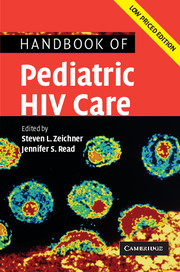Book contents
- Frontmatter
- Contents
- List of contributors
- List of abbreviations
- Foreword
- Preface
- Part I Scientific basis of pediatric HIV care
- Part II General issues in the care of pediatric HIV patients
- 3 Diagnosis of HIV infection in children
- 4 Prevention of mother-to-child transmission of HIV
- 5 Routine pediatric care
- 6 Emergency evaluation and care
- 7 Adherence to antiretroviral therapy in children and youth
- 8 Adolescents and HIV
- 9 Growth, nutrition, and metabolism
- 10 Neurobehavioral function and assessment of children and adolescents with HIV infection
- Part III Antiretroviral therapy
- Part IV Clinical manifestations of HIV infection in children
- Part V Infectious problems in pediatric HIV disease
- Part VI Medical, social, and legal issues
- Appendix 1 Formulary of antiretroviral agents
- Appendix 2 National Institutes of Health sponsored clinical trials for pediatric HIV disease
- Appendix 3 Selected HIV-related internet resources
- Appendix 4 Selected legal resources for HIV-infected children
- Index
- References
4 - Prevention of mother-to-child transmission of HIV
Published online by Cambridge University Press: 23 December 2009
- Frontmatter
- Contents
- List of contributors
- List of abbreviations
- Foreword
- Preface
- Part I Scientific basis of pediatric HIV care
- Part II General issues in the care of pediatric HIV patients
- 3 Diagnosis of HIV infection in children
- 4 Prevention of mother-to-child transmission of HIV
- 5 Routine pediatric care
- 6 Emergency evaluation and care
- 7 Adherence to antiretroviral therapy in children and youth
- 8 Adolescents and HIV
- 9 Growth, nutrition, and metabolism
- 10 Neurobehavioral function and assessment of children and adolescents with HIV infection
- Part III Antiretroviral therapy
- Part IV Clinical manifestations of HIV infection in children
- Part V Infectious problems in pediatric HIV disease
- Part VI Medical, social, and legal issues
- Appendix 1 Formulary of antiretroviral agents
- Appendix 2 National Institutes of Health sponsored clinical trials for pediatric HIV disease
- Appendix 3 Selected HIV-related internet resources
- Appendix 4 Selected legal resources for HIV-infected children
- Index
- References
Summary
Introduction
Over the past several years, major successes have been achieved in prevention of mother-to-child transmission (MTCT) of human immunodeficiency virus type 1 (HIV). However, these successes have occurred primarily in those countries with the greatest resources and the lowest burden of HIV infection among women and children. Significant challenges remain, particularly in those countries with more limited resources and a greater population burden of HIV infection. Each day an estimated 2000 infants become infected with HIV, virtually all residing in resource-poor settings [1]. MTCT of HIV can occur during pregnancy, at the time of labor and delivery, and postnatally (through breastfeeding) [2]. Rates of MTCT of HIV have been calculated in studies conducted around the world in the absence of interventions to decrease transmission [3]. Overall, most studies reported a transmission rate in the range of 25%–30% and higher transmission rates were observed in resource-poor settings (13%–42%) than in resource-rich settings (14%–25%). In this chapter, risk factors for MTCT of HIV will be reviewed briefly. In addition, interventions for the prevention of MTCT of HIV will be discussed, both those already shown to be efficacious and those under study. Finally, strategies to prevent MTCT of HIV will be addressed.
Risk factors for, and interventions to prevent, mother-to-child transmission of HIV
Numerous risk factors for MTCT of HIV have been identified or are under investigation [4].
- Type
- Chapter
- Information
- Handbook of Pediatric HIV Care , pp. 107 - 133Publisher: Cambridge University PressPrint publication year: 2006



